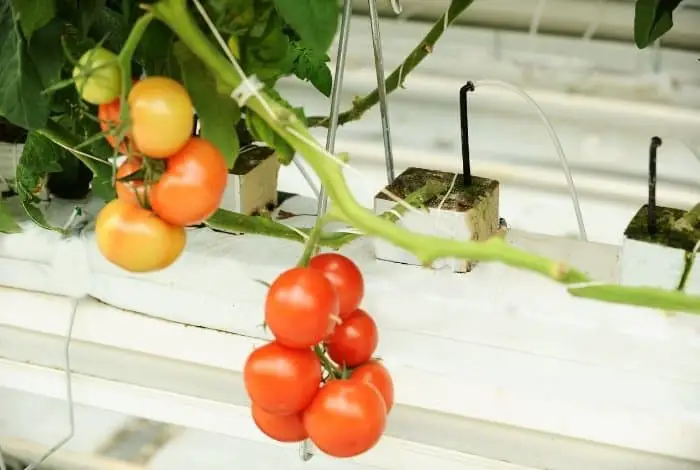Last Updated on February 10, 2022
If you love having fresh tomatoes at your disposal, then growing tomatoes with hydroponic will be of great benefit to you. You can get to enjoy fresh tomatoes for your salad, sandwich, fried greens, etc, in the comfort of your home.
You can achieve great success with growing tomatoes in hydroponics. With tomatoes grown from hydroponics, you not only get faster growth, but you will also as well enjoy greater fruit production.
Hydroponics is a more reliable and easy way of cultivating your favorite fruit plants without any mess from the soil. Growing tomatoes in hydroponic will make your gardening lifestyle comfortable and smooth. We will be discussing more about the hydroponic tomato systems so let’s begin.
Growing Hydroponic Tomatoes: Getting Started
When it comes to cultivating tomatoes with hydroponics, you can pick any kind of hydroponics. They will grow pretty well in all types of hydroponics systems.

Types of Hydroponics Set up for Tomatoes
There are 6 types of hydroponics set up and they include:
- Ebb and flow (or Flood and drain system).
- Hydroponic drip.
- Deepwater culture.
- Aeroponic system.
- F.T (Nutrient Film Technology).
- Wick system.
Whichever system you decide to go for will do well for your tomatoes. However, in this guide, we will briefly talk about the ebb and flow and deep water culture system.
Ebb and Flow System for Hydroponic Tomatoes
You can decide to set up a DIY ebb and flow hydroponic system. However, we recommend a much easier option to go for which is to purchase a hydroponic kit. A hydroponic kit will contain all the components needed to set up your ebb and flow hydroponics system. All you need to do is to follow instructions to set up your complete ebb and flow system with ease.
Ebb and flow systems also known as flood and drain systems channels a well nutrient-filled solution. The nutrient-filled solution will pump up into the grow tray and flood your tomato plant providing adequate nutrients for your tomato plant.
When the nutrient reaches the overflow, the system will later drain the nutrient solution back into its reservoir. This way, your tomato plant won’t be sitting in a nutrient-filled solution longer than it’s supposed to.
You can even set a timer with an automated hydroponics kit to precisely time the floods the nutrient solution should sit in the grow tray.
Read more about Vertical Hydroponics System
General Hydroponics Waterfarm Complete Hydroponic System Grow Kit
Deep Water Culture For Hydroponic Tomatoes
Another type of hydroponics that works well with tomatoes is deep water culture (DWC). DWC is a simple, easy, and affordable type of hydroponics and it’s especially great for beginners.
Deepwater culture makes use of a net pot fitted in a reservoir where the tomato plants are placed and engulfed in water. There is also an air pump required for oxygenating the water.
Types of Tomato Cultivars Grown For Hydroponic Tomatoes
There are mainly two types of tomato cultivars you can grow.
- Determinate: determinate variety can be grown in a small space variety and they grow like a bush. Therefore, if you are short of space, you should go for the tomato that is a determinate variety.
- Indeterminate: if you have adequate space to work with a larger plant then you can go for indeterminate variety. This variety will grow continuously on a vine. Thus, they will need some support with trellis as they continue to grow.
Seed Germination or Transplanting Tomatoes in Hydroponic
We do not recommend transplanting tomato seedlings from the soil into your hydroponics. Pathogens or pests from dirt can be introduced into your hydroponics and can cause great havoc to your entire tomato crop.
We recommend you germinate your tomato seed using Rockwool, coconut coir, or perlite as a growing medium. Your tomato seeds will germinate well in a warm and damp environment. They will sprout well with 70-80 degree temperature. You should begin to see sprouting within 5 to 10 days.
When they are about 7 to 9 inches long, you can now transfer them to your hydroponic system.
Harvesting
Depending on the variety you choose, tomato seeds will take about 10 days to sprout and around 4 to 6 weeks to transplant. Then around 4 to 8 weeks, your tomato should begin fruiting and turn red meaning they are ready for harvest.
Additional Information
Whichever variety of tomatoes you decide to pick, ensure they are adequately spaced. You can also make use of a flexible room so you can move around your plants easily when pruning or harvesting. This is because they will start growing big and pruning will most likely be needed so they don’t get out of control.
Also, ensure you feed your growing hydroponic tomatoes with adequate grow light for maximum yield. You should also feed your tomato plants with a good nutrients package.

Eunice is an enthusiastic gardener with a passion for growing beautiful flowers. She loves nothing more than spending time in her garden, tending to her plants and enjoying the outdoors. Eunice has been gardening for over 15 years and has developed a unique style of landscaping that is both practical and aesthetically pleasing. She is especially fond of growing roses and enjoys experimenting with different varieties and colors. Eunice takes great pride in her garden and often shares the fruits of her labor with friends and family. In her spare time, she enjoys reading gardening magazines and attending local horticulture events. Eunice is passionate about her hobby and is always eager to share her knowledge and experience with others.

